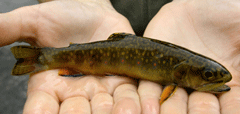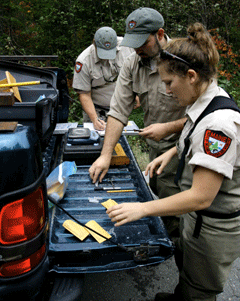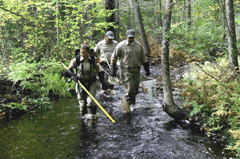Buckets of Trout
Air Date: Week of October 24, 2008

A brook trout from a central Maine stream. Brook trout populations have declined dramatically in the southern portion of their range, but many Maine streams still hold wild, native trout. (Photo: Murray Carpenter)
Brook trout are native to much of the eastern United States. But recent studies show that their populations are low in their historical habitat, primarily because of degraded streams, warming waters, and introduced fish species. In Maine, however, brook trout are thriving. Producer Murray Carpenter waded in the water with a team of Maine biologists to survey the state’s stream-dwelling trout.
Transcript
GELLERMAN: Brook trout were once plentiful in North America’s rivers and streams. You’d find them all the way from Georgia to Newfoundland, and as far west as Ohio. But the fish are now scarce in much of their former range, except for Maine. It’s the brook trout’s last, best refuge. It’s where for the past two years, state biologists have been surveying Maine’s waterways, and as Murray Carpenter reports, they’re finding plenty of trout.
[WADING SOUNDS]
CARPENTER: It’s 10 a.m. on a mild autumn day in rural Maine. Chip Wick wades up a stream wearing a fifty-pound backpack that holds an electrofishing unit. He turns it on…
[MACHINE BEEPS]
CARPTENTER: … and starts fishing. He waves a yellow wand in the water ahead of him, and trails a cable in the water behind. Wick’s three-person crew is searching for brook trout, and they don’t have to look too hard.
WICK: There’s one up here, right there, right underneath that stick, straight ahead, straight ahead, you got ‘em!
CARPENTER: As Wick wields the beeping shocker, Tyler Grant and Amy Preble handle the nets. Soon they’ve got five trout in the bucket.

Maine Department of Inland Fisheries and Wildlife biologists Chip Wick, Tyler Grant and Amy Preble use the tailgate of their pickup as a streamside lab. After they measure the brook trout and take tissue samples for later analysis, they release the fish back into the stream. (Photo: Murray Carpenter)
WICK: That’s five of ’em, you can see they are stunned for a little while, but they come back out of it pretty quickly.
CARPENTER: Ten yards from the road, and you’ve got a bucket full of trout.
WICK: Yep, yep, pretty small stream, it doesn’t look like much more than a drainage ditch really. But if they’ve got a constant flow of water and the right water temperatures, they can hold trout year round.
CARPENTER: After sampling a 50-yard reach of stream, the crew carries the bucket back to the tailgate of the pickup, which they transform into a sort of field lab. First they measure the trout.
WICK: Number one is 120 millimeters … 13.8 grams…
CARPENTER: Then they clip some fin tissue for later genetic analysis, and scrape off a few scales for growth studies. Soon the trout go back into the brook.
This study was prompted by a 2005 report by a coalition called the Eastern Brook Trout Joint Venture. The report showed that wild brook trout are missing or greatly reduced in nearly half of their historic range, because of degraded streams, warming waters and competition from introduced fish. The report also noted that the fish are assumed to be thriving in most of Maine, which is further north and less developed than other states with brook trout, but quantitative data was missing.
GALLAGHER: For lake and pond habitats we have about 97 percent of the nation’s resources. But we couldn’t say that for stream habitats because we did not have adequate data.
CARPENTER: Merry Gallagher, a biologist with the Maine Department of Inland Fisheries and Wildlife is leading the Maine brook trout study. She says trout in the southern part of the range are limited by a lack of cold, clean water, and have been harmed by a variety of land uses.
GALLAGHER: It’s agricultural and development concerns. In some of the Appalachian regions of West Virginia, Pennsylvania, it’s mining practices because severe degradations in water quality that don’t allow trout to persist, and other fishes in many cases, too.

While Amy Preble wields the electrofishing unit, which includes a 50-pound backpack, Chip Wick and Tyler Grant catch temporarily stunned fish in their nets. This Penobscot County stream was holds a good variety of minnows, and plenty of brook trout.
CARPENTER: Gallagher says brook trout are good indicators of healthy watersheds. That’s why the Eastern Brook Trout Joint Venture is considered a pilot project for a series of national fish habitat action plans.
GALLANGHER: So we’re talking about an animal that needs to move freely, has relatively strict habitat requirements as far as water quality and the physical features of its habitat, so it’s a good animal for a large-scale conservation effort, which is what we are striving for.
CARPENTER: The sampling project cost about $250,000 a year. It was primarily funded with federal dollars, with support from the state of Maine and some money from nonprofits such as Trout Unlimited.
Jeff Reardon is Trout Unlimited’s New England conservation director.
REARDON: Maine is to brook trout what Alaska is to Pacific salmon, it’s the place you have large numbers of intact populations in the streams they evolved in, in something like their natural state. That’s pretty remarkable if you think about the changes we’ve put on these watersheds over the last three or four hundred years.
[RIPPLING WATER]
CARPENTER: Back in central Maine, Wick’s crew surveys the third of four sites they’ll cover today. In addition to looking for trout, they test water quality, and generally evaluate the habitat. While many of Maine’s lakes and large rivers have already been overrun by non-native fish like smallmouth bass, most little streams still hold a variety of native fish. The crew tallies these on their data sheets.

A brook trout from a central Maine stream. Brook trout populations have declined dramatically in the southern portion of their range, but many Maine streams still hold wild, native trout. (Photo: Murray Carpenter)
GRANT: Common… blacknose… creek chub… finescale… We’ve got another brookie here.
CARPENTER: While the crew sorts fish, Gerald Myrick stops by to see what’s going on. An outdoorsman wearing a camouflage baseball cap, he lives just up the road and says he knows this tiny brook well.
MYRICK: I’ve lived here all my life, and I’ve fished it all my life, so yes, I know there’s trout here. A lot of times this one’s almost dry, but you’ll find a hole with six inches of water, and you’ll find the trout.
CARPENTER: Myrick’s observation seems to sum up the situation in much of Maine, where the sampling crews have been surprised to find trout even in muddy little trickles. This winter, biologists Wick and Gallagher will be working indoors, mapping their findings. And many of those vast areas of the Maine brook trout distribution map that now say, “no quantitative data” will soon read “populations intact,” at least for now.
For Living on Earth, I’m Murray Carpenter, in Penobscot County, Maine.
MYRICK: Brookie, nice brookie!
Living on Earth wants to hear from you!
Living on Earth
62 Calef Highway, Suite 212
Lee, NH 03861
Telephone: 617-287-4121
E-mail: comments@loe.org
Newsletter [Click here]
Donate to Living on Earth!
Living on Earth is an independent media program and relies entirely on contributions from listeners and institutions supporting public service. Please donate now to preserve an independent environmental voice.
NewsletterLiving on Earth offers a weekly delivery of the show's rundown to your mailbox. Sign up for our newsletter today!
 Sailors For The Sea: Be the change you want to sea.
Sailors For The Sea: Be the change you want to sea.
 The Grantham Foundation for the Protection of the Environment: Committed to protecting and improving the health of the global environment.
The Grantham Foundation for the Protection of the Environment: Committed to protecting and improving the health of the global environment.
 Contribute to Living on Earth and receive, as our gift to you, an archival print of one of Mark Seth Lender's extraordinary wildlife photographs. Follow the link to see Mark's current collection of photographs.
Contribute to Living on Earth and receive, as our gift to you, an archival print of one of Mark Seth Lender's extraordinary wildlife photographs. Follow the link to see Mark's current collection of photographs.
 Buy a signed copy of Mark Seth Lender's book Smeagull the Seagull & support Living on Earth
Buy a signed copy of Mark Seth Lender's book Smeagull the Seagull & support Living on Earth

